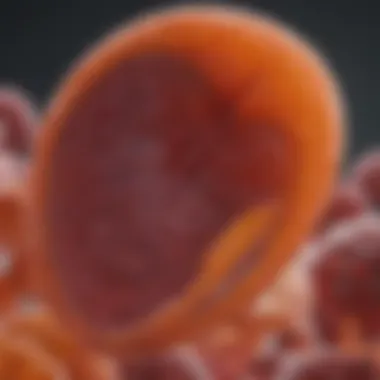Understanding Stage 4 Gallbladder Cancer Treatment


Intro
Stage 4 gallbladder cancer represents an advanced stage of the disease where the cancer has likely spread beyond the gallbladder to other parts of the body. This progression often presents significant challenges both in terms of treatment and in establishing the prognosis for patients. Understanding the nuances surrounding life expectancy in stage 4 gallbladder cancer and the available treatment options is crucial for patients, families, and healthcare professionals alike.
This article aims to dissect the complexities of this medical condition. It will explore the various factors influencing life expectancy, delve into the range of treatment options, and present important survival statistics. By providing a clear and thorough overview, readers gain insights that can guide them in decision-making processes during a difficult time.
Foreword to Stage Gallbladder Cancer
Stage 4 gallbladder cancer signifies a critical juncture in the disease's progression. At this advanced stage, the cancer has likely spread beyond the gallbladder to other organs, making treatment more complicated. Understanding this stage matters because it helps patients, families, and healthcare providers navigate the challenging landscape of treatment options and prognosis.
Awareness of the details surrounding stage 4 gallbladder cancer fosters informed decisions. This knowledge is essential for evaluating treatment possibilities, understanding survival statistics, and recognizing factors that influence life expectancy.
By delving into the specifics of this disease stage, one can better grasp the nuances of managing gallbladder cancer. This comprehension is crucial not just for immediate care but also for long-term management and support strategies.
Definition and Overview
Gallbladder cancer is a malignancy that arises from the cells lining the gallbladder. It often remains asymptomatic until it reaches an advanced stage, like stage 4. At this point, the aggressive nature of the cancer means it can invade surrounding tissues, lymph nodes, and more distant organs.
The classification of gallbladder cancer follows the TNM system, where T indicates the size and extent of the tumor, N indicates the spread to nearby lymph nodes, and M signifies metastasis to distant sites. In stage 4, the cancer manifests as extensive involvement, significantly complicating treatment efforts.
Importance of Understanding Life Expectancy
Life expectancy in stage 4 gallbladder cancer is a complex topic, influenced by various factors. Grasping the average survival rates provides insights into the serious implications of this diagnosis. However, it is vital to recognize that these statistics are general estimates; individual prognosis can vary significantly.
Factors affecting life expectancy may include:
- The patient’s age and overall health
- Response to treatment options
- Presence of associated health conditions
Understanding these elements helps in creating realistic expectations regarding treatment outcomes. This is especially important for patients and their families, as it can shape decisions about treatment and palliative care strategies.
Understanding Gallbladder Cancer Staging
Understanding the staging of gallbladder cancer is vital for assessing the disease's severity and informing treatment decisions. Staging refers to the classification of cancer based on its size, location, and extent of spread. For patients diagnosed with stage 4 gallbladder cancer, knowing the stage helps in understanding the prognosis.
Stage 4 typically means the cancer has metastasized to distant organs and tissues. This differentiation between stages helps medical professionals recommend appropriate therapies and gives patients and families a realistic view of expected outcomes. It is a crucial stage in the overall timeline of the disease and will shape the kind of discussions around treatment options, management of symptoms, and support systems.
The Staging Process
The staging process for gallbladder cancer involves several key steps. Initially, the oncologist reviews the patient’s medical history and conducts a physical examination. Imaging tests such as ultrasound, CT scans, or MRIs are then employed to determine the tumor's size and whether it has spread.
- Initial Evaluation: This is usually the first step and involves understanding symptoms.
- Imaging Techniques: These often provide clear images to evaluate the tumor.
- Biopsy: In some cases, a sample may be taken to confirm cancer.
Determining the full extent of cancer's spread relies heavily on these methods. Accurate staging is essential because it promotes personalized treatment strategies. Moreover, it plays a role in clinical trials where stage-specific protocols are in place.
Differences between Stage and Earlier Stages


The differences between stage 4 gallbladder cancer and earlier stages are stark and impactful. In lower stages, tumors are often localized, meaning there may be hope for surgical removal or effective treatment with lower side effects. In contrast, stage 4 signifies invasion into neighboring organs or distant metastasis.
- Stage 1-3: Tumors may remain localized, allowing for surgical options, including possible curative intent.
- Stage 4: Surgical removal becomes less feasible as cancer has spread, often limiting treatment to palliative care or systemic therapies.
Fighting against the cancer, in its advanced stage, requires understanding these differences. it affects not only treatment but the psychological and emotional concerns faced by patients and families.
Recognizing these distinctions allows both healthcare providers and patients to align expectations and prepare adequately for the journey ahead. The shift from earlier stages to stage 4 is a critical milestone that necessitates thoughtful dialogue and planning.
Life Expectancy for Stage Gallbladder Cancer
Understanding life expectancy in stage 4 gallbladder cancer holds significant weight for patients and their families. This knowledge guides important decisions, including treatment options and lifestyle adjustments. Moreover, discussing a prognosis can help in preparing emotionally for what lies ahead.
Survival rates provide valuable insight into what patients may expect. Knowing the average duration of survival allows patients to align their expectations with reality. Considerations for life expectancy can also shape treatment choices. Choices regarding aggressive treatments or supportive care often hinge on these statistics. Thus, having a clear grasp of life expectancy opens the door for informed decisions on care, quality of life, and end-of-life planning.
Average Survival Rates
Average survival rates for stage 4 gallbladder cancer are generally disheartening. Most data suggest a low five-year survival rate, often cited around 3% to 5%. This reflects the advanced nature of the disease, where cancer has usually spread beyond the gallbladder and into other parts of the body. Factors such as health care access and advancements in treatments may influence these statistics.
While numbers are concerning, it is crucial to remember they are averages. Individual circumstances can lead to variations in life expectancy. Factors such as geographical location and the specific characteristics of the cancer itself can affect survival outcomes. Patients often receive a unique prognosis after assessment by their oncologist, considering individual health and treatment plans.
Factors Affecting Life Expectancy
Age of the Patient
The age at which a patient is diagnosed with stage 4 gallbladder cancer plays a crucial role in life expectancy. Younger patients tend to have better resilience and may respond more favorably to treatments. The body's ability to tolerate therapies can differ significantly with age. For instance, individuals in their 50s or younger often exhibit a better tolerance to chemotherapy compared to the elderly.
However, this is not universally applicable. Older patients might have pre-existing health conditions that can complicate treatment. These complexities may lead to a more conservative approach, leading to shorter life expectancy.
Overall Health Status
The overall health status of a patient is another significant factor impacting life expectancy. Patients who maintain a healthy lifestyle and have no prior serious health conditions typically fare better. Being in good health may allow for more aggressive treatment options, which can prolong survival.
For instance, patients without comorbidities can handle surgeries or harsher chemotherapy. Conversely, those with conditions like diabetes or cardiac issues might need tailored treatments. This can provide both advantages in quality of life yet present challenges in prolonging life.
Response to Treatment
Finally, the response to treatment can greatly influence life expectancy. Some patients may respond exceptionally well to chemotherapy or targeted therapies, resulting in longer survival. Early responsiveness can lead to extended periods of remission, allowing for improved quality of life.
Conversely, a poor response can lead to complications and a decrease in survival time. Oncologists often monitor reactions to therapies closely, adjusting treatment plans based on responses. This ensures the strategy is as effective as possible given the circumstances.
Treatment Options for Stage Gallbladder Cancer
Understanding the treatment options available for stage 4 gallbladder cancer is crucial for patients and their families. This stage indicates advanced disease, where the cancer has spread beyond the gallbladder and may affect nearby organs, lymph nodes, or other parts of the body. Decisions about treatment can significantly impact the patient’s quality of life and overall prognosis. Therefore, knowing the various treatment modalities is essential, as it enables patients to make informed decisions that align with their personal health goals and preferences.
Surgical Treatments


Surgery for Palliation
Surgery for palliation aims to relieve symptoms caused by the cancer rather than to cure the disease. In stage 4 gallbladder cancer, palliation may involve procedures that alleviate pain or improve bile flow. This type of surgery is worth considering for patients who experience symptoms like jaundice, nausea, or obstruction. The key characteristic of this surgical option is its focus on improving the quality of life rather than extending life expectancy.
By addressing these symptoms, palliation can lead to significant benefits for the patient, such as enhanced comfort and a better ability to engage in daily activities. However, surgery for palliation does not stop cancer progression. Its unique feature is that it can be a low-risk procedure compared to more extensive surgeries. On the downside, recovery from palliation surgery is variable and may not always result in quick symptom relief.
Surgery for Tumor Reduction
Surgery for tumor reduction involves removing as much of the gallbladder cancer as possible. This option is primarily considered when the cancer has not extensively spread or when symptoms are significant enough to warrant such an intervention. The key characteristic here is the potential for reducing tumor burden, which can have a positive impact on other treatment options like chemotherapy or radiation therapy.
Surgery for tumor reduction can be beneficial for patients who are relatively healthy and have a good performance status. It might lead to improved symptoms and potentially extend survival. However, limitations exist; the operation's success hinges on the exact stage of cancer spread, and it is not appropriate for every patient. Adverse effects may include significant surgical risks and a lengthy recovery period.
Chemotherapy Options
Types of Chemotherapy
Chemotherapy is a common treatment for stage 4 gallbladder cancer and often involves a combination of drugs. Specific regimens may include drugs like gemcitabine and cisplatin, among others. The primary goal of chemotherapy is to kill cancer cells or stop them from dividing. One of the key characteristics of chemotherapy is its capacity to manage cancer's spread systemically, targeting any remaining cancer cells throughout the body.
This method is popular as it can be administered in an outpatient setting, thus allowing patients to maintain some normalcy in their lives during treatment. One unique feature is the ability to tailor chemotherapy regimens to individual patient needs based on factors like overall health and tumor characteristics. However, chemotherapy does come with potential side effects, including nausea, fatigue, and hair loss, which can be challenging for patients.
Goals of Chemotherapy
The goals of chemotherapy in stage 4 gallbladder cancer can differ significantly based on individual circumstances. The primary aim might be to control growth, relieve symptoms, or improve the patient's overall quality of life. This tailored approach helps address the specific needs of each patient and shapes treatment goals that align with their preferences and health status.
One important characteristic is that chemotherapy may also serve as an adjunct to other therapies such as surgery or radiation. This integrated model can potentially lead to superior outcomes. The unique feature of having clear goals—for instance, stabilization of disease versus shrinkage—allows for better monitoring of treatment effectiveness. However, it is essential to weigh these goals against possible side effects and overall treatment feasibility.
Radiation Therapy
Role of Radiation Therapy
Radiation therapy plays a role in the treatment of stage 4 gallbladder cancer, mainly for palliative care or as an adjunct to other treatment modalities. It can help reduce tumor size, alleviate pain, and manage complications caused by the cancer’s spread. One key characteristic of radiation is its focus on targeted cancer cells, minimizing damage to surrounding healthy tissue. This quality makes radiation a valuable option.
Furthermore, radiation therapy can sometimes be effective at controlling symptoms of advanced cancer, which is vital for enhancing patient quality of life. One drawback is that radiation typically requires multiple sessions, leading to increased visits to the treatment center.
Side Effects to Consider
Side effects of radiation therapy can vary, but common issues include fatigue, skin irritation, and localized pain. Understanding these side effects is crucial for patient preparation and management during treatment. The primary characteristic of these side effects is that they often develop gradually. In some cases, they may persist or worsen over time.
Patients need to be aware of these factors, as side effects might impact their decision regarding whether to proceed with radiation therapy. One of the unique features of side effects is that they can present challenges but, with proper management, can be mitigated to a large extent. Balancing the benefits of pain relief or symptom management against these effects is a key consideration for patients and medical providers.
The treatment choices for stage 4 gallbladder cancer can shape the experience and outcomes for patients. As such, it is critical to have thorough discussions with healthcare providers to tailor the treatment plan to each individual's unique situation.
Emerging Treatments and Clinical Trials
Emerging treatments and clinical trials represent a critical frontier in the fight against stage 4 gallbladder cancer. As knowledge and technology continue to evolve, these innovations may provide hope to patients facing dire life expectancy predictions. For many, participating in clinical trials can offer access to therapies that are not yet widely available, bringing the potential for improved outcomes in their treatment journey.


The significance of ongoing research cannot be underestimated. Emerging treatments often include novel drug combinations, immunotherapies, and targeted therapies designed to address the biological drivers of gallbladder cancer more directly. By focusing on the specific genetic or molecular subtypes of cancers, researchers aim to increase the efficacy of treatment while potentially reducing side effects. This tailored approach not only helps in enhancing patient survival but also improves the quality of life during treatment.
"New therapies being studied today will form the basis of tomorrow’s standard care."
Furthermore, clinical trials serve as a vital resource for gathering data about cancer progression and treatment efficacy. The results obtained from these trials inform future therapeutic strategies and guidelines for medical practice. For the patients involved, the possibility of finding an effective treatment alternative offers a significant motivation to engage in these studies.
Innovative Therapies Under Research
Innovative therapies for stage 4 gallbladder cancer are at the forefront of medical research. Researchers are exploring several promising avenues, including:
- Targeted Therapies: These therapies focus on inhibiting specific pathways or mutations that contribute to cancer growth. For example, therapies targeting the HER2 protein have shown beneficial effects in some patients.
- Immunotherapy: This method leverages the patient's own immune system to identify and fight cancer cells. Checkpoint inhibitors and CAR T-cell therapy are examples of such innovations under investigation.
- Combination Therapies: Researchers are studying the effects of combining different modalities, such as chemotherapy with immunotherapy, to see if they can produce better results than individual treatments.
- Gene Therapy: This approach aims to alter genes in targeted cancer cells to either restore normal function or enhance the immune response to tumors.
These therapies represent the cutting-edge of cancer treatment, and many researchers believe they hold the key to improving survival rates for advanced-stage patients.
Importance of Participation in Clinical Trials
Participating in clinical trials is a crucial component of advancing cancer treatment. Several essential benefits underscore the importance of involvement:
- Access to New Treatments: Many trials offer treatments that are not yet available to the general public, providing options that could be more effective than current standard therapies.
- Comprehensive Medical Care: Patients in trials receive close monitoring and care, often experiencing more frequent assessments and access to specialized medical teams.
- Contribution to Science: By participating, patients contribute to the broader understanding of gallbladder cancer, helping researchers develop future therapies that may benefit others.
- Potential for Better Outcomes: Although not guaranteed, some participants have experienced improved outcomes that surpass current treatments due to the innovative nature of trial protocols.
Psychosocial Considerations for Patients and Families
Understanding stage 4 gallbladder cancer is not just about medical treatments or life expectancy statistics. It is also crucial to consider the psychosocial aspects that impact patients and their families. The emotional, psychological, and social challenges are often as significant as the physical ones. Patients may face feelings of fear, anxiety, and depression throughout their treatment journey. Their families also experience these stresses, sometimes amplified by their caregiving roles. Therefore, addressing these psychosocial elements can improve overall well-being and coping mechanisms for both patients and caregivers.
Psychological Support and Counseling
Psychological support plays a vital role in the management of stage 4 gallbladder cancer. Many patients benefit from speaking with mental health professionals who specialize in oncology. Counseling can help individuals process their diagnosis and treatment, facilitating healthier emotional responses. Supportive therapy can provide a safe space for patients to express their fears and concerns. It can also equip them with coping strategies.
Furthermore, family counseling can be beneficial. It allows families to discuss their experiences openly, enhancing mutual understanding. In many cases, groups of patients share their experiences, thereby reducing isolation. Through platforms, such as support groups, patients can find community and connection, which is often comforting in navigating the complexities of their condition.
Managing Expectations and Outcomes
Managing expectations is critical in the journey with stage 4 gallbladder cancer. Patients and families often grapple with the uncertainty of prognosis and treatment outcomes. It is essential to understand that life expectancy statistics are averages and cannot predict individual outcomes. Continuously communicating with healthcare providers about what to expect during treatment can help ground patients and their families.
Counselors and healthcare professionals can assist patients in setting realistic goals related to their treatment. They can help adjust expectations based on the patient’s specific circumstances and overall health. This emphasis on realistic goal setting aids in reducing disappointment and frustration.
"The state of mind plays a fundamental role in physical health. Managing emotional health is therefore a step towards better overall outcomes."
Culmination
Understanding stage 4 gallbladder cancer is vital for patients, families, and healthcare professionals. The complexities of the disease at this advanced stage necessitate a thorough comprehension of various aspects, including life expectancy, treatment options, and psychosocial impacts. This conclusion consolidates the key elements discussed throughout the article, highlighting how treatment modalities can differ in effectiveness based on individual cases.
Summary of Key Points
- Life Expectancy: For stage 4 gallbladder cancer, survival rates are generally low, often estimated around 4 to 8 months with treatment, but various factors can influence this.
- Treatment Options: Multiple treatment strategies exist including surgery, chemotherapy, and radiation therapy, each with its own goals and potential outcomes.
- Emerging Research: Participation in clinical trials can provide patients access to innovative therapies that may improve their prognosis.
- Psychosocial Support: Emotional and psychological support is crucial for patients and their families, assisting them in coping with diagnoses and treatment impacts.
- Prognostic Factors: Age, overall health status, and the body's response to treatment play significant roles in determining individual life expectancy.
Final Thoughts on Prognosis and Treatment
The prognosis for stage 4 gallbladder cancer remains a challenging aspect of oncology. While the general outlook can seem bleak, it is important to recognize that advancements in medical science continue to emerge, offering new hope to patients. Treatment decisions should be made collaboratively with healthcare providers, taking into consideration both medical factors and patient preferences. As new therapies develop and research expands, patients should remain informed about their options and actively engage in discussions regarding their care. Establishing a robust support system, whether through professional counseling or support groups, can enhance the overall quality of life in this difficult journey.
"Knowing the landscape of stage 4 gallbladder cancer equips patients and families to make more informed decisions about treatment and support."
In summary, while stage 4 gallbladder cancer poses significant challenges, understanding its nuances empowers stakeholders to navigate this complex disease effectively, improving both patient experience and outcomes.















